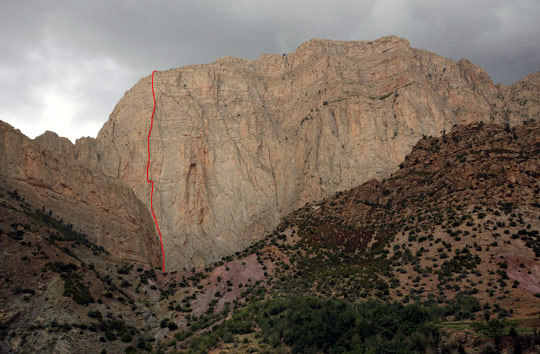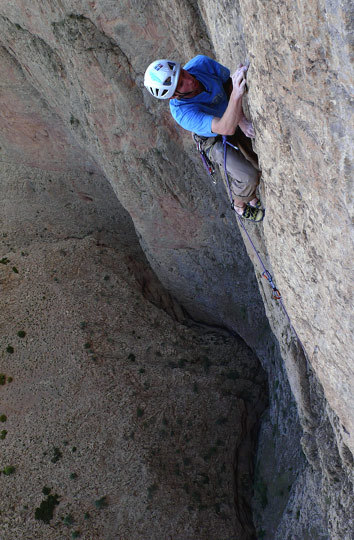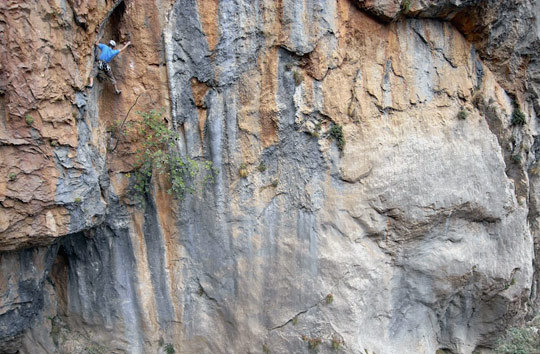
The red line marks all but the first three pitches of Babel (7c+ [5.13a], 18 pitches, 800m), Tagoujimt Tsouiant (2977m), Atlas Mountains, Morocco. Arnaud Petit, Titi Gentet, Nicolas Kalisz and Stephanie Bodet cleaned, bolted (sparsely) and climbed the sustained line over fifteen days in September. Babel is the second sport route on this face, after Fantasia (7c, 650m, Kaszlikowski-Kubarska, 2004), which climbs just left of the big roof. [Photo] Courtesty of Arnaud Petit
Titi Gentet, Nicolas Kalisz, my wife Stephanie Bodet and I have just returned from the village of Taghia in the Atlas Mountains of Morocco, where we spent fifteen days opening a new 800-meter line on Tagoujimt Tsouiant (2977m), an immense wall north of Taghia. This area has become a destination for climbers searching out beautiful and difficult climbs. Several aid routes have been opened there since 1976, and more recent development has focused on bold, ground-up free routes. On my first trip to Taghia Cirque in 2002 I had seen Tagoujimt Tsouiant–it’s visible from the village–but I lacked the imagination then to conceive of this fantastic new line.
On our route, Babel (7c+ [5.13a], 18 pitches, 800m), we found the climbing to be demanding and sustained. The psychological aspect of the climb is just as (if not more) important as the physical and the technical. The overall difficulties, the beauty of certain pitches, and the environment and breadth of the wall combine to make Babel an exceptional big-wall free climbing experience.
The route is consistent at variations of grade 7, and the climbing is always runout, sometimes dangerously. We opened the line with minimal bolting, free climbing between the protection points and hanging on hooks, nuts, or pitons to haul the drill and place the bolts. This approach is referenced by some as “Larcher style”: sparse bolting and mandatory, engaging free climbing between bolts. On our route, the obligatory free climbing between bolts registered as difficult as 7a+ (5.12a). On the hardest pitches, bolts were spaced 4 meters apart. On easier sections, around 6c (5.11b), we placed bolts every 7 to 8 meters. Despite the demanding climbing, primary difficulties in opening this route arose in finding good Skyhook placements for drilling bolts, as the rock of the north face proved to provide few truly positive edges for the hooks.
As a team, we did not connect all the pitches of Babel in one push. Instead, we preferred to use our time to clean thoroughly those pitches that required such efforts. However, by the trip’s end, Nicolas succeeded in climbing all the route’s pitches free.

Arnaud Petit on Pitch 10 (7c+ [5.13a]). The team bolted the route “Larcher style,” resulting in a relatively sustained eighteen pitches in which “the climbing is always runout, sometimes dangerously.” [Photo] Courtesty of Arnaud Petit
Ten days after we finished opening the line, Yann Ghesquiers, one of the best all-round climbers in the world, and Didier Angonin climbed the route in one day. Yann was able to onsight every pitch (not all on lead), and Didier fell or rested on four different occasions. Upon their return from the climb, the pair insisted that the mandatory, runout climbing and spaced bolting are justified (in the context of the style the route was established). “The return to this style of climbing is sometimes stressful, especially as the route does not lend itself to safe falls–breaking an ankle would be a very real possibility. It is necessary to prevent this sort of thing and to start out on this route as if in a great race up the mountain,” Yann said. Added Didier, “The pleasure, once you are finished with the business, is at the top!”
Stephanie, Titi, Nicolas and I approached the route in the spirit of climbing within our mental, physical and technical limits. With the opening of this line we are well aware that we spaced the bolts a little too far apart on certain pitches. But we made the choice not to add bolts after our ascent, for we had already passed through the unknown on uncleaned rock. It is certain that Babel will not immediately become a great classic. However, the route will remain a fantastic test of control for the best climbers. A caveat remains–one should not be lured to the route because the topo makes the route seem straightforward. The route is not to be taken lightly, as it demands a cool head and, moreover, extreme perseverance.
Babel adds itself to the list of the Taghia’s most difficult routes, including On the Wire of the Night (7c+ [5.13a], 560m, Larcher-Oviglia-Paissan, 2003), The Great Carnival, (8a+ [5.13c], 500m, Gentet-Petit-Piola, 2004) and Widmo, (8a [5.13b], 500m, Samitowski-Grochard-Fic, 2004). But, according to Yann and Didier (whose assessment reflects our opinion as well), Babel is more demanding in terms of engagement, with two or three pitches of exposed climbing characterized by more complexity than that of On the Wire of the Night. Of the eighteen pitches of climbing, fourteen check in at 7a (5.11d) or greater. Climbing the route in a day is a formidable challenge due to the sustained difficulty. Bivouacs on Pitch 14 and Pitch 11 are options, but in the case of the latter, a portaledge would be preferable.
Stephanie and I have returned to Taghia every year since 2002, and we have made many friends. To open Babel, a line just opposite the village, knowing that our friends followed us with binoculars, was a great pleasure. Of course, we are looking forward to returning again.

Arnaud Petit climbs through the shrubbery on Pitch 1. The team spent numerous days cleaning the route. [Photo] Courtesty of Arnaud Petit